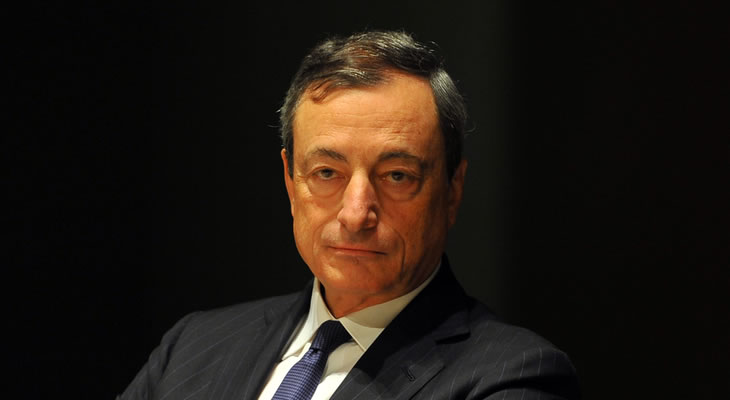The Euro to Pound Sterling, (EUR/GBP), Canadian Dollar (EUR/CAD), US Dollar (EUR/USD) and New Zealand Dollar (EUR/NZD) exchange rates were all trending lower in the early hours of Friday’s session, after the European Central Bank (ECB) announced it would be implementing quantitative easing (QE).
Foreign exchange expert Dennis de Jong stated: ‘Mario Draghi has been left with the choice than to begin a more robust than expected quantitative easing programme in a bid to awake the economies of the Eurozone from their slumber.’
‘This play is seen by many as the last roll of the dice for the beleaguered Euro. QE has had some success in the US and UK, but with such a patchwork of economies and banking systems in the Eurozone, the jury is very much out.’
Earlier… The Euro to Pound Sterling (EUR/GBP), Canadian Dollar (EUR/CAD), US Dollar (EUR/USD) and New Zealand Dollar (EUR/NZD) exchange rates fell as European Central Bank President Mario Draghi announced new asset backed purchases.
The ECB will make monthly purchases of €60 billion until the end of 2016, a program that will begin in March.
Earlier… The Euro exchange rate depreciated against the Pound Sterling (EUR/GBP) and Canadian Dollar (EUR/CAD) while recording gains against the US Dollar (EUR/USD) and New Zealand Dollar (EUR/NZD) ahead of the European Central Bank’s (ECB) stimulus announcement.
The 12:45 GMT announcement failed to offer any hints about the ECB’s monetary policy stance, we’re now awaiting ECB President Mario Draghi’s speech at 13:30.
The Euro hit an 11-year low against the US Dollar (EUR/USD) as speculation surrounding the central bank’s next actions heightened. Investors have forecast that the ECB will undertake a period of quantitative easing (QE) to help revive the Eurozone’s flailing 19-nation economy.
Today will be an exciting day for Euro trading with exchange rate fluctuations expected to follow the announcement.
Industry expert Daniel Gros commented: ‘At stake here is the credibility and the unity of monetary policy in the Euro area. But it is a very divisive move, and the way it is executed might only reinforce the divisions in the region.’
Meanwhile, the US Dollar is awaiting the release of Initial Jobless Claims, Continuing Claims and House Price Index stats later on Thursday. The US Dollar has been bullish in the market for some time as investors expect Federal Reserve rate hikes to materialise in the near future.
Despite signs of a global slowdown, some economists are forecasting the US housing market will bolster the US economic recovery and encourage the Fed to adjust borrowing costs.
Economist Mark Zandi stated: ‘Housing will be pivotal to growth this year and next. Stronger housing is needed to offset the ill effects of a deteriorating trade balance and less investment in energy.’
Joseph LaVorgna stated: ‘Housing will give the Fed more confidence.’
Bank of Canada Rate Cut Pressures Canadian Dollar (CAD) and New Zealand Dollar (NZD) Lower
Close neighbour Canada saw its central bank cut interest rates on Wednesday in a move that took the market by surprise. The recent near 60% decline in oil prices has pressured the Canadian Dollar exchange rate lower and hindered growth in the North American nation.
Bank of Canada Governor Stephen Poloz stated: ‘The oil price shock increases both downside risks to the inflation profile and financial stability risks. [The cut is] intended to provide insurance against these risks and support the adjustments needed to return the economy to full output.’
The move took markets by surprise and many economists now expect other central banks to slash rates.
Economist Sal Guatieri commented on the Bank of Canada’s (BOC) surprise move saying: ‘It’s a shocker. It is an aggressive move. It speaks volumes about where the Bank of Canada sees the economy and inflation going.’
However, as the price of oil keeps weakening, the economy is going to feel the effects.
Economist Charles St-Arnaud stated: ‘This signals the BOC is very concerned. This means that the oil shock will be much greater than people expected.’
One nation to be affected by the BOC rate cut is New Zealand.
As lower inflation hits economies all over the world, commodity currencies are becoming more vulnerable than usual. New Zealand’s own Consumer Price Index showed a drop in inflation in the fourth quarter of 2014—a development that many investors took as a sign of stable interest rates after an aggressive hiking cycle last year.
Inflation fell from 1.0%, to 0.8%, below the forecast 0.9%.
Foreign exchange expert Tim Kelleher commented: ‘The market is strongly pricing in some rate cuts now, quiet aggressively. They’ve taken out any forecast in rate hikes for 2016. The risk is they’re more dovish than they have ever been lately.’
The Bank of Canada move got more investors twitchy about riskier high yielding currencies such as the New Zealand Dollar as the prospect of worldwide rate cuts becomes a very real possibility.
Currency strategist Raiko Shareef commented: ‘The usual reaction would be that Canada is a commodity currency and we fell in sympathy, but the real reaction is this idea that central banks have suddenly got a whole lot more surprising.’
Euro Exchange Rate Forecast: EUR/GBP, EUR/CAD, EUR/USD, EUR/NZD
The Euro (EUR) exchange rate is extremely likely to fluctuate on the ECB action on Thursday and if the ECB announces a large-scale QE program, the Euro could drop.
Friday will see the release of Markit’s Purchasing Managers Indexes (PMI) for both the Eurozone and Germany which could influence the Euro exchange rate.
The Euro to Canadian Dollar (EUR/CAD) exchange rate is reaching 1.4321. The Euro to New Zealand Dollar (EUR/NZD) currency pair is trading around the 1.5376 benchmark. The Euro to Pound Sterling (EUR/GBP) exchange rate is trending in the region of 0.7656. The Euro to US Dollar (EUR/USD) exchange rate resides at 1.1616.

